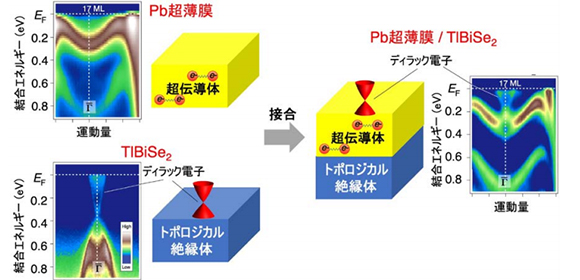
Method to convert conventional superconductors into topological superconductors
New approach to explore candidate topological superconducting materials
A group of researchers from Tohoku University, Osaka University, Kyoto Sangyo University, and University of Cologne (Germany) has developed a new method for converting conventional superconductors into topological superconductors (TSCs).
They grew a conventional superconductor lead (Pb) thin film on a topological insulator (TI) TlBiSe 2 , finding that the topological surface state (SS) migrated to the surface of Pb film and the conventional superconductor converted into a TSC.
TIs are insulators in their interior (bulk) but possess a conducting metallic region called a "metallic Dirac electron state” on the surface of a three-dimensional (3D) TI and on the edge of a 2D TI. TIs, especially TSCs, a peculiar class of superconductors, have drawn attention.
Unlike conventional superconductors, Majorana fermions are thought to be present in TSCs. A Majorana fermion serves as its own anti-particle and it is anticipated that they can be utilized for quantum computing because they are immune to environmental noise and impurities.
When a superconductor is placed in contact with a "normal" non-superconductor, the superconducting proximity effect (SPE) induces superconductivity. Scientists have tried to realize TSCs, which produce Majorana fermions, through SPE, but it is difficult to probe Majorana fermions because the SPE occurs at an interface buried deep beneath the surface. Thus, Majorana fermions have not been detected with use of the SPE.
Using a molecular-beam epitaxy technique, this group grew a Pb film of several nm on the surface of topological insulator TlBiSe 2 (which was found by this group in 2010). The superconductivity shows up on the Pb film.
Dirac-cone state, where the energy is linear in momentum, is supposed to be embedded at the Pb/TlBiSe 2 interface, but this group observed a Dirac-cone-like band on the band structure of TlBiSe 2 . This indicates that the Dirac-cone state of substrate TlBiSe 2 migrated to the top surface of Pb film and obtained an energy gap below the superconducting transition temperature of Pb.
They also performed ultrahigh-resolution angle-resolved photoemission spectroscopy (ARPES) to measure the energy and momentum of electrons inside a solid, at low temperatures, clearly recognizing a typical signature of the superconducting-gap opening. This shows that Dirac electrons form pair states (Cooper pairs), inducing superconductivity.
These findings suggest that it is possible to realize topological superconductivity without the SPE and that the conversion of conventional superconductors to TSCs is realized through interaction when Pb interfaces with TlBiSe 2 .
This group showed a new approach in exploring candidate topological superconducting materials; the conversion of conventional superconductors into TSCs. This new method has high versatility and can be applied to various combinations of superconductors and topological insulators.
Figure 1
Figure 2
Figure 3
The article, "Con version of a conventional superconductor into a topological superconductor by topological proximity effect," was published in Nature Communications at DOI: https://doi.org/10.1038/s41467-019-13946-0 .
Related Links
